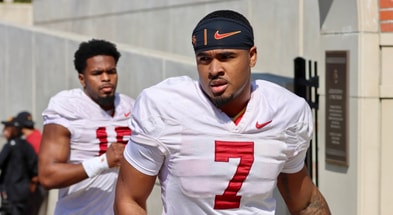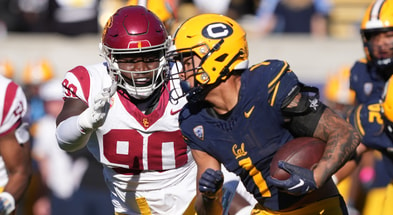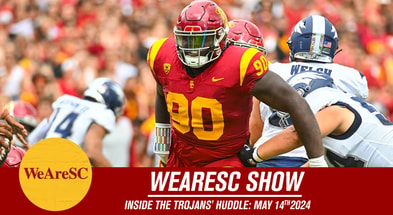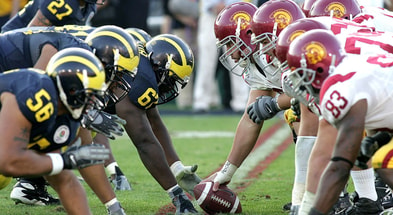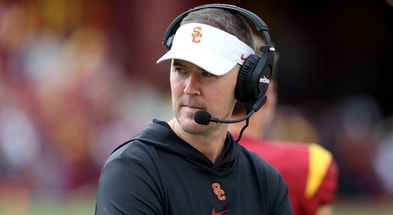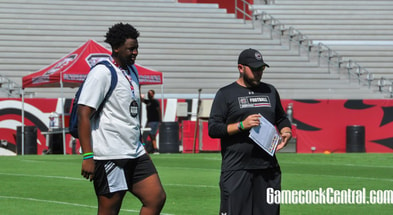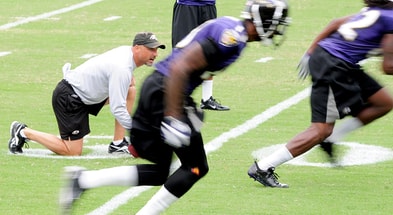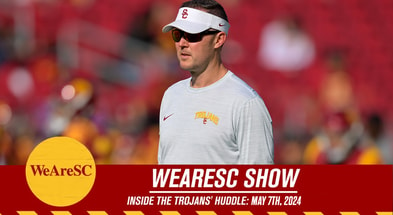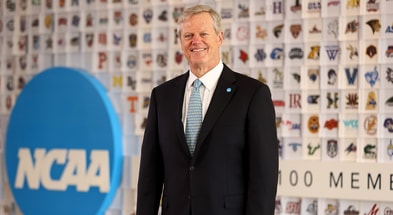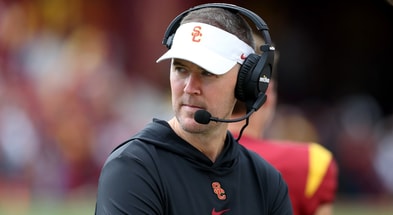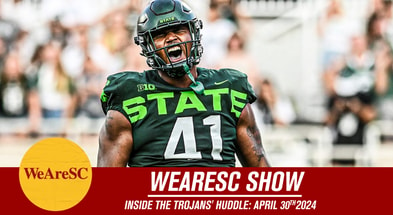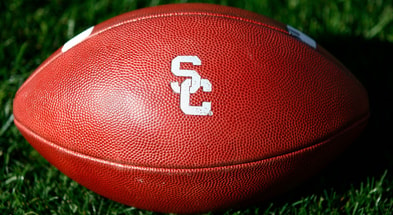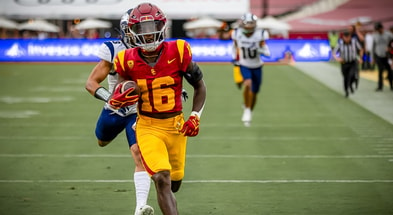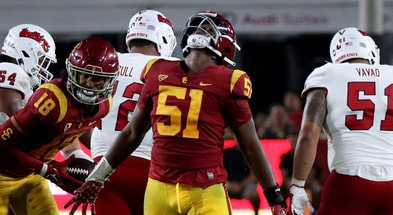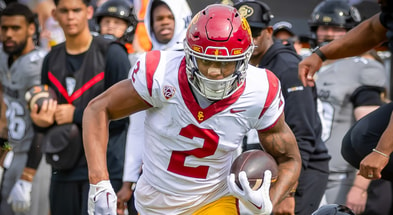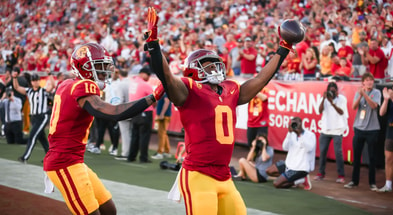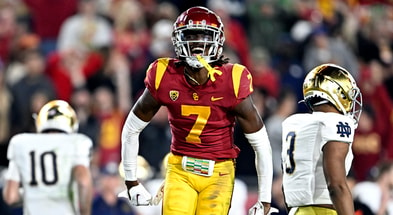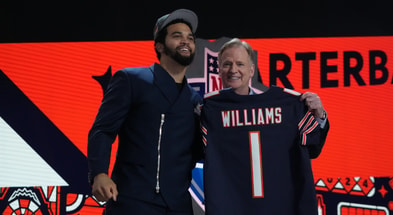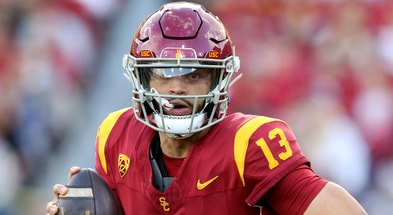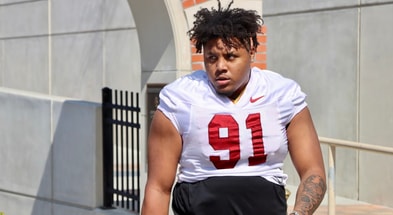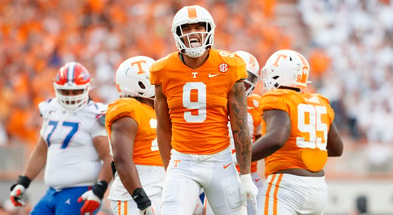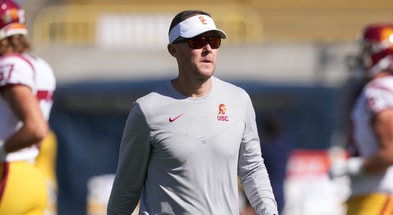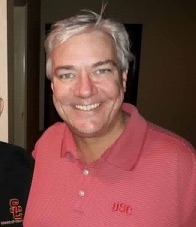Musings from Arledge: USC's Signing Day and NIL
Is this the class that Lincoln Riley was shooting for when he left Oklahoma for USC? I suspect it’s not. It’s a good class; it has some future first-round draft picks, I think; it’s also probably a minor disappointment. Minor. And stick with me. This requires some explanation and at least one major caveat.
We should probably start with this: how do you judge a recruiting class?
USC will come in just outside the top 10 in the rankings. Does that matter? I think it does. The ratings aren’t perfect. Some highly-rated guys are overrated; some future stars come in under the radar. But top-5 classes are top-5 classes for a reason. It is not an accident that Georgia and Alabama seem to have more talent than almost any other program. They also, not coincidentally, rank in the top few recruiting classes every year. When Pete Carroll was dominating the college football world, he was also dominating the annual recruiting rankings. There’s a relationship there.
The strong correlation between recruiting rankings and national titles or between recruiting rankings and NFL draft status is too strong to ignore. If you haven’t looked at the many analyses showing the connection, Google it. There’s plenty out there. At this point, those who say recruiting rankings don’t matter are willfully ignorant. Top programs on the field are almost always the top programs on the recruiting ranking lists, and the fact that some programs manage to waste top recruiting classes – like Texas A&M does; like USC has at times in the past – doesn’t change how important it is to land the guys that everybody thinks are the top players. Because most of the time, everybody is right.
On this basis, it’s hard to see this recruiting class as anything other than a mild disappointment (with that major promised caveat, discussed below). Lincoln Riley came to USC because he thought he could put together the best roster in college football. He was open about that. Recruiting at this year’s level will not accomplish that goal. Simply put, if USC wants to compete with Georgia and Alabama on the field, USC needs to recruit like those programs. This year’s class is not a Georgia or Alabama class.
That doesn’t mean USC has a bad class. It’s a good one. The Trojans are bringing in some fantastic football players. Zach Branch, Makai Lemon, and Tackett Curtis are can’t-miss superstars. Riley talked about all three in his press conference today. He said Tackett Curtis is the best linebacker in the country. That’s believable. What a combination of athleticism and physicality. He talked about Makai Lemon, who I think could be a future All-American on either side of the ball. He talked about Zach Branch being a guy that just doesn’t come along very often because of his combination of rare explosiveness and high-level football skills. In fact, I’ll go on record as saying Branch will be better in the open field than anybody USC has had since Reggie Bush. The kid is magic.
Malachi Nelson is obviously a fantastic prospect. (No QB is a can’t-miss prospect, in my opinion, but Nelson is as close as you can get.) Both Texas running backs look physical and fast enough, and I trust Lincoln Riley and Kiel McDonald when it comes to evaluating running backs. On the offensive and defensive lines we have guys that I think are significantly underrated; Sam Greene, Elijah Hughes, and Braylan Shelby are, in my opinion, elite prospects who will terrorize quarterbacks over the next few years. Riley included David Peevy in that group as a front-seven guy at the very top of their wish list all year.
But let’s be honest about something: these offensive and defensive line recruits better prove to be underrated, because USC did not hit on many of the highest-rated players in these critical areas according to the pundits. If you follow recruiting you know about some of those major misses. And the Trojans do not have the numbers they need at linebacker or in the secondary.
It continues to be frustrating that USC is missing out on key players to schools like Miami and Oregon. USC fans tend to assume this is all about bags of cash, and maybe it is, although I would also point out that the coaching staffs at those schools have well-earned reputations as great recruiters. I don’t know if Cristobal, Lanning, and Lupoi are great football coaches. But I know they’re great salesmen.
If USC is operating at an NIL deficit, either we’ll get some enforceable rules*, or USC will change its approach, or USC will continue to miss out on top-tier talent. I don’t know how that will play out, although I don’t think USC changing its approach is an option. Riley was clear in his press conference that the rules seem clear to him and USC intends to follow them. USC will not be promising NIL money to recruits for a signature on a letter of intent. It’s not going to happen. And he acknowledged that USC missed out on some recruits as a result.
But Riley seems to believe that USC still has a lot to offer the right kind of recruit. USC’s pitch will be about the team, about education, and only then about NIL dollars. Still, he says USC’s current players have done well in NIL. USC’s players earned twice what USC expected them to earn this year, and that was despite USC’s projections being “aggressive” in Lincoln Riley’s words. Players can earn money at USC; ask Caleb Williams.
I also question whether all of the recruiting misses are due to bags of cash. I’m quite sure Alabama has been giving money to players since both money and players were invented, but I also think Nick Saban complained about Jimbo Fisher this offseason for a reason, and that reason is that Alabama cannot compete with the big dogs in the bags-of-cash department. (Bama was better positioned when a free trip to the local car dealer was the going rate.) Yet Bama will still clean up in recruiting this year. Cash may be a factor, but it’s not all about the cash.
Can I make one more practical point on this? If USC is losing players because it won’t compete with other programs in the checkbook department, that’s sometimes a good thing. I wouldn’t pay seven figures to land DJ Lagway (obviously a 2024 recruit). He’s a highly talented but unproven kid who needs to develop. I’m not sure I commit big dollars to a kid like that, because if Lincoln Riley needs a quarterback in a couple of years, he’ll pull a stud out of the portal – just like he did with Baker Mayfield, Kyler Murray, Jalen Hurts, and, yes, Caleb Williams. I’m not worried about that.
But I am worried about the strength of the locker room, and so is Lincoln Riley. He said in his press conference that some schools are fixated on one guy, are not focused on the entire locker room, and that this is a dangerous thing to do. Maybe the exodus from Texas A&M is related to their recruiting practices? Giving a few guys a big bag of money is giving a big bag of resentment to a lot of their teammates. It’s one thing if some company gives your teammate an advertising deal. It’s another thing if you coach is directing the check.
I’m also not interested in pursuing guys with cash just because of a high ranking. If Oregon flipped Matayo Uiagalelei with a bag of cash – and I don’t know if that’s what happened – that’s fine. Please understand, I wanted Matayo. He’s a big, athletic kid. I think he’ll turn out to be a solid contributor. But I’ve also watched him play. There’s no way that kid, who never dominated at the high school level even though he played on a team of studs and was never going to be the focus of any offensive coordinator’s attention, is truly a five-star defensive end. Again, I wanted him to sign with USC. This is not sour grapes. It’s reality. He’s not TJ Watt or Nick Bosa. Not even close.
There are high school prospects so good that you’ll have a hard time finding a replacement in next year’s class or in the portal. Matayo isn’t a guy like that. He’s replaceable. If NIL money is the difference in recruiting now – if, that is, players are commodities like labor in other industries – sometimes it’s better just to let your competitor overpay.
One important caveat to all this: the transfer portal has dramatically changed what signing day means. It used to be that the only way for a program to build an elite roster was to sign great high school classes every year, and holes in a recruiting class could spell future doom. That’s not true now.
High school recruiting is still critical. But the transfer portal makes shoring up a roster much easier than it used to be. USC’s class last year was small and not highly rated according to the major services. But USC also landed Caleb Williams, Travis Dye, Jordan Addison, Eric Gentry, and Mehki Blackmon – among others – in the transfer portal. And any recruiting period that leads to five instant all-conference players, including the best player in the country, and a half dozen of other key starters is a great recruiting period, whether it shows up in the rankings or not.
USC had some misses this year in recruiting. I can think of an offensive lineman or two that would have been very nice to land. I’m disappointed about that, and I suspect Lincoln Riley is, too. But Riley will likely fill those holes with proven transfers. This is a dramatic change from years past.
One final point on recruiting. Can we stop with the way we talk about recruits that choose other programs? There’s no reason to trash a kid personally. We can talk about his skills on the field. We can critique his decision. But even if we think the kid made a dumb choice – he turned down Stanford for Oregon State?! – that’s no reason to attack him as a person. Plenty of 19-year-old kids make short-sighted decisions. Most turn out okay. Even if we think a recruit made his decision based on an NIL check, that doesn’t mean a kid is unethical or of bad character. I don’t work for free when people are willing to pay me. Do you?
Matayo chose Oregon when USC thought he’d choose a real program. So be it. There’s no reason to assault his character or intelligence.
At the same time, we can also stop saying things like “I wish him the best” or “I wish him the best except when he plays USC.” I don’t. And why would I? I don’t have ill feelings toward a kid who chooses Oregon. I don’t want him to contract syphilis or get hit by a train. But why would I wish him the best, either? If a player spurns USC for Oregon, I want him to lose every game and never make a tackle. I then want him to graduate, get a good job, and have a happy life. If that’s what you mean by wishing him the best, I’m on board. If you’re saying you hope he plays well on the football field, count me out. I wish no such thing. If you choose Oregon, may your future hold only gridiron failure and shame.
* About those enforceable rules. I think they’re coming. Just not through the rotted corpse of a corrupt and ineffective NCAA. I think they’re coming because college athletes will become employees of the university and will enter into collective bargaining agreements. You probably saw the headline this week about the National Labor Relations Board pushing for this outcome with USC athletes.
This is probably the best possible outcome for a variety of reasons. First, you can get around the anti-competition laws with a collective bargaining agreement. You can impose salary caps and rules governing free agency without running afoul of the Sherman or Clayton Acts. But – and this is very important to me – you can also make sure that players get a fair deal. A lot of money is being made in college football, and I want the players to get a big chunk of that money.
Second, collective bargaining can take the politics out of some of the decisions that have to be made. Football and (to a lesser extent) basketball generate huge revenues for the top programs. That means football and basketball players should get paid more than baseball or lacrosse players. This would be common sense in almost any other industry, but when it comes to the types of people who run universities and the complications of Title IX and the fact we live in an age when some women’s sports teams claim to be underpaid compared to men who generate many multiples of the revenues the women’s teams generate, common-sense economics is no given. With a real bargaining unit and honest negotiations, we’re likely to get a much fairer set of rules than we’d get leaving these sorts of decisions to NCAA bureaucrats, university bureaucrats or politicians.
So, as expected, UCLA gets permission from the politicians to join the Big 10 instead of having to stay and suffer through athletic-department bankruptcy. Apparently, not even the politicians truly believe that it’s better for the student-athlete to be stuck in a department with tens of millions in debt and no path out.
Also as expected, UCLA will pay blood money to Cal, because it’s bad for Cal, which is bad, to stay in a conference it helped to make bad – or something like that. These things can get very confusing.
But did anybody catch that UCLA might have to pay up to $5 million per year in welfare to the Bears. Why $5 million? The University of California’s own analysis concluded that UCLA’s departure would cost the remaining members of the conference $3 million per year and USC’s departure would cost them $10 million per year. So why isn’t the number $3 million? Does UCLA have to pay Cal compensation to make up for the loss of USC revenue? Sounds like it. Sounds unfair. It also sounds hilarious. Sorry, Bruins.
Whatever happens in the Cotton Bowl, USC is a handful of players, most especially front-seven defensive guys, from being a legitimate national title contender next year. And I think they’re making progress on that front.
USC will score big points next year. The Trojans just need a decent defense; a group that can sometimes hold good offenses under 40. If things play out as I expect, the additions from the transfer portal will give USC a viable defense, and next season will be very exciting.
I know the schedule is tough. The road game at Oregon is nasty. A road game in South Bend is always a challenge, though I think Notre Dame won’t be any better next year than they were this year. But USC can lose one of those two road games and still make the playoff if they win out otherwise.
So the Trojans need to win in Eugene or South Bend, and they need to handle UCLA, Washington, and Utah at the Coliseum. That’s not easy, but it’s doable. Look at it this way: those teams have to figure out a way to outscore Caleb Williams on his home field. Good luck.
And one more thing about future prospects. Lincoln Riley said in his press conference today that this year’s team is likely to be the least-talented team they will have. He was clear that he loves these guys, their attitude, their effort, the way they play together. But USC will be more talented next year than this year. It will likely be more talented in 2024 than in 2023. The Trojans didn’t get everybody I wanted them to get. But there is no doubt in my mind that this program is still on the upswing. Very good days are ahead.
Carthago delenda est is a long ways in the rear-view mirror.
